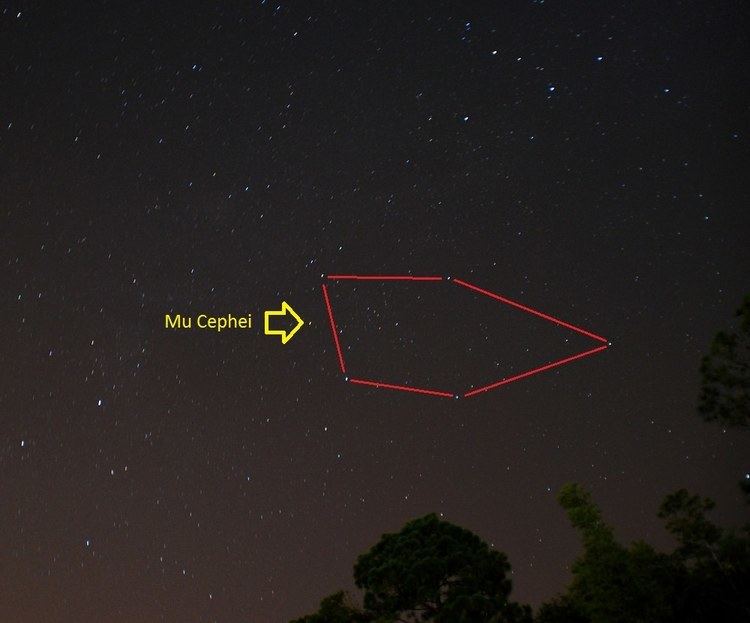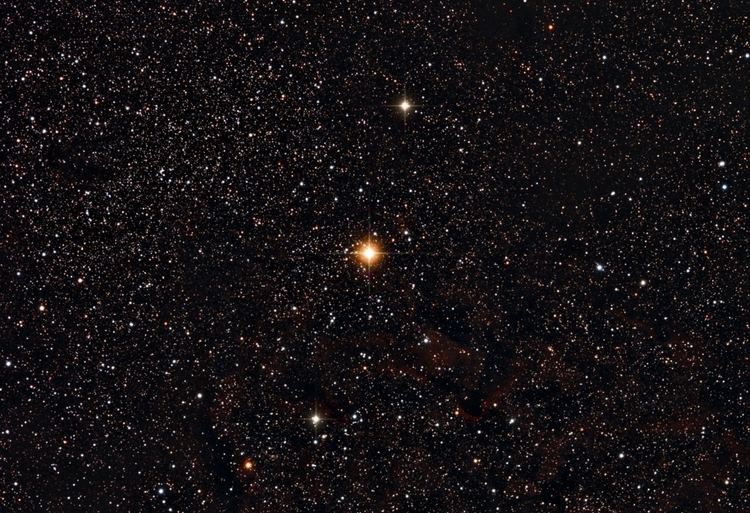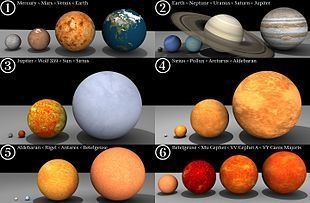Surface temperature 3,690 K | Magnitude 4.08 Apparent magnitude (V) 4.08 | |
 | ||
Radius 720.4 million km (1,035 R☉) Mass 3.819 × 10^31 kg (19.2 M☉) Similar VV Cephei, V354 Cephei, KY Cygni, VY Canis Majoris, WOH G64 | ||
Mu Cephei (μ Cep, μ Cephei), also known as Herschel's Garnet Star, is a red supergiant star in the constellation Cepheus. It appears garnet red and is located at the edge of the IC 1396 nebula. Since 1943, the spectrum of this star has served as the M2 Ia standard by which other stars are classified.
Contents

Mu Cephei is visually nearly 100,000 times brighter than the Sun, with an absolute visible magnitude of Mv = −7.6. Summing radiation at all wavelengths gives a luminosity of around 280,000 L☉ (bolometric magnitude −8.8), making it one of the most luminous red supergiants in the Milky Way. It is also one of the largest stars so far discovered.

History

The deep red color of Mu Cephei was noted by William Herschel, who described it as "a very fine deep garnet colour, such as the periodical star ο Ceti". It is thus commonly known as Herschel's "Garnet Star". Mu Cephei was called Garnet sidus by Giuseppe Piazzi in his catalogue. An alternative name, Erakis, used in Antonín Bečvář's star catalogue, is probably due to confusion with Mu Draconis, which was previously called al-Rāqis [arˈraːqis] in Arabic.

In 1848, English astronomer John Russell Hind discovered that Mu Cephei was variable. This variability was quickly confirmed by German astronomer Friedrich Wilhelm Argelander. Almost continual records of the star's variability have been maintained since 1881.
Variability
Mu Cephei is a variable star and the prototype of the obsolete class of the Mu Cephei variables. It is now considered to be a semiregular variable of type SRc. Its apparent brightness varies erratically between magnitude 3.4 and 5.1. Many different periods have been reported, but they are consistently near to either 860 days or 4,400 days.
Properties
A very luminous red supergiant, Mu Cephei is likely to be the largest star visible to the naked eye, and one of the largest known. It is best seen from the northern hemisphere from August to January.
This is a runaway star with a peculiar velocity of 80.7 ± 17.7 km/s. The distance to Mu Cephei is not very well known. The Hipparcos satellite was used to measure a parallax of 0.55 ± 0.20 milliarcseconds, which corresponds to an estimated distance of 1,333–2,857 parsecs. However, this value is close to the margin of error. A determination of the distance based upon a size comparison with Betelgeuse gives an estimate of 390 ± 140 parsecs, so it is clear that Mu Cephei is either a much larger star than Betelgeuse or much closer (and smaller and less luminous) than expected.
The star is approximately 1,260 R☉ (880,000,000 km; 540,000,000 mi), and were it placed in the Sun's position, its radius would reach between the orbit of Jupiter and Saturn. Mu Cephei could fit around 2 billion Suns into its volume.
The photosphere of Mu Cephei has an estimated temperature of 3,750 K. It may be surrounded by a shell extending out to a distance at least equal to 0.33 times the star's radius with a temperature of 2,055 ± 25 K. This outer shell appears to contain molecular gases such as CO, H2O, and SiO.
Infrared observations suggest the presence of a wide ring of dust and water with an inner radius about twice that of the star itself, extending to about four times the radius of the star.
The star is surrounded by a spherical shell of ejected material that extends outward to an angular distance of 6″ with an expansion velocity of 10 km s−1. This indicates an age of about 2,000–3,000 years for the shell. Closer to the star, this material shows a pronounced asymmetry, which may be shaped as a torus. The star currently has a mass loss rate of a few times 10−7 M☉ per year.
Supernova
Mu Cephei is nearing death. It has begun to fuse helium into carbon, whereas a main sequence star fuses hydrogen into helium. When a supergiant star has converted elements in its core to iron, the core collapses to produce a supernova and the star is destroyed, leaving behind a vast gaseous cloud and a small, dense remnant. For a star as massive as Mu Cephei the remnant is likely to be a black hole. The most massive red supergiants will evolve back to blue supergiants, Luminous blue variables, or Wolf-Rayet stars before their cores collapse, and Mu Cephei appears to be massive enough for this to happen. A post-red supergiant will produce a type IIn or type II-b supernova, while a Wolf Rayet star will produce a type Ib or Ic supernova.
